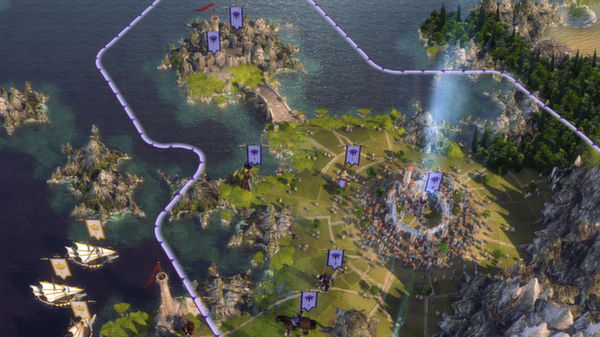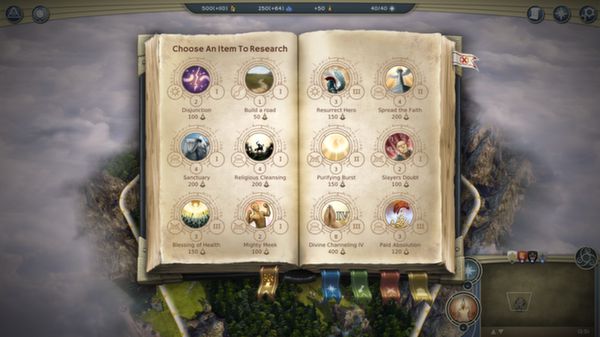 The Age of Wonders series is often mentioned alongside Heroes of Might and Magic as being one of the most influential franchises that shaped the fantasy subgenre of 4X games. Differentiating itself from games like Civilization, Age of Wonders featured turn-based combat, multiple planes like surface and underground levels, and customizable hero units that gained levels and could equip powerful magical items and cast world-changing spells. Both heavily influenced by Master of Magic in 1994, Age of Wonders and Heroes of Might and Magic did a lot to advance the 4X genre and help fill the void left behind by Master of Magic‘s lack of a follow-up.
The Age of Wonders series is often mentioned alongside Heroes of Might and Magic as being one of the most influential franchises that shaped the fantasy subgenre of 4X games. Differentiating itself from games like Civilization, Age of Wonders featured turn-based combat, multiple planes like surface and underground levels, and customizable hero units that gained levels and could equip powerful magical items and cast world-changing spells. Both heavily influenced by Master of Magic in 1994, Age of Wonders and Heroes of Might and Magic did a lot to advance the 4X genre and help fill the void left behind by Master of Magic‘s lack of a follow-up.
As with the previous games, Age of Wonders III is about starting with a single tiny village and building up a massive empire. Maps are littered with resources, independent cities that can be conquered by force or negotiation, roaming parties of bandits and assorted creatures, and various dungeons and tombs that often hide magical items. The eXplore in this fantasy 4X is one of its strongest features, and the game highly encourages you to check every little nook and cranny in each map to see what crazy items or spells you can find. That next tomb you raid could contain anything from a powerful sword to a gold wyvern egg that will hatch into a mount for one of your heroes to ride into battle. Maybe you’ll gain a spell that allows you to summon evil dire penguins that steal life with each peck of their beaks.
There are five core races in the game, in the usual High Elf, Dwarf, Orc, Human, and Goblin varieties. Some people will be disappointed to learn that each race doesn’t have particularly drastic differences between them; their strengths and weaknesses are more subtle and won’t become truly apparent until you’re more familiar with the game’s mechanics. No matter the race, each city has the same sort of buildings available to it and somewhat equivalent units with minor variations. The Goblin Untouchable is roughly the same as a Dwarven Prospector in the sense that they are both Tier 1 Irregular units with a more combined arms focus, but they have subtle differences like how the Prospectors can tunnel through dirt walls and the Untouchables shoot debilitating poisons. Each race has inherent immunities, weaknesses, and terrain preferences that dictate the best places to establish cities. Things don’t start to really get different between the races until you reach their Tier 3 unit. The High Elves get knights riding flying griffin mounts, while the Orc Shock Troopers are more along the lines of sturdy frontline infantry.
Maps will often have dwellings for secondary races that are quite different than the standard five, like Fairies with their multi-elemental Fey Fire ranged attacks or Giants that can serve as massive living siege engines. These races cannot be picked at the start of a game though; the only way to acquire them is to find and absorb their cities into your empire.
In any case, the race you choose isn’t quite as important as your main hero’s class. There are six classes that all have their own special units and unique spells, upgrades, and enchantments. There’s the technology-focused Dreadnought, the stealthy and deceitful Rogue, the nature-worshiping Archdruid, the aggressive Warlord, the religious zealotry of the Theocrat, and the more traditional fire and lightning spells of the Sorcerer. Any race can be any class, and there isn’t any real benefit or penalty for choosing a specific combination. A Goblin can just as easily be an angelic Theocrat as any other race, and Dwarves don’t have a monopoly on the muskets and steam-driven war machines of the Dreadnought like in many other fantasy settings.

The class-specific units and abilities are some of the most interesting in the game. I especially like the steampunk Dreadnought class, with its Flame Tanks that explode into fiery shrapnel upon death and the massive Juggernaut land ships bristling with cannons and mortars. One of the Dreadnought’s ultimate spells is basically a fantasy nuke, called the Destabilized Mana Core. Archdruids can summon all manner of gargantuan forest creatures, like giant vipers that spit venom or horned forest gods that call down lightning. No matter what class you choose, you are bound to find tons of interesting spells, upgrades, and impressive units.
Your heroes are once again the centerpiece to your forces. They are highly customizable, both in appearance and abilities. The scenarios and random maps have a long list of premade heroes to play as, or you can make your own by choosing their race, class, customizing their appearance, and choosing three specializations that add to the sort of spells and abilities you can research in addition to the class-specific stuff. As heroes level up they’ll gain experience points that can be used to purchase abilities. Some only affect the hero itself, but many are applied to all units in the army the hero is leading. A Rogue can give all their units poisoned weapons, allowing them to deal additional Blight damage, while a Theocrat could make his troops into exalted holy zealots that are revived at the end of combat should you win the battle. Tombs and dungeons are often full of items you can give your heroes, from weapons and armor to magical mounts like hellhounds or unicorns that grant the rider special buffs. You can even craft your own magical items if you build a forge in one of your cities.
There is a rather underdeveloped morality system in the game too. Certain actions, like razing a city or slaughtering independents that have already surrendered, are considered “Evil,” while actions like absorbing conquered cities into your empire or negotiating peaceful deals with other wizards are considered “Good.” The whole thing is based on traditional, clichéd notions of good and evil, and for the most part I don’t think the game does a very good job of handling this system. Being “Good” or “Evil” doesn’t have a huge effect outside of the morale of certain units and the way some AI characters react to you. Most importantly, I never really see the point in being evil, as evil choices are universally just dumb. Plundering a city (an evil act) might give you some cash in the short term, but I’ve never seen a situation where plundering/razing a conquered city is better than just absorbing it into your empire.
Sometimes you can’t avoid doing “good” or “evil” acts. Killing a unit with the Dedicated to Good ability gives you “evil points,” if you will, which is pretty arbitrary and can’t be helped sometimes. What if my city was just attacked by units Dedicated to Good/Evil? I have to kill them to defend my territory. Same with declaring war or similar “aggressive” acts that are considered evil. The system is just poorly thought out and tries to force morality onto you. It has the same problems that all morality systems with good/evil “meters” have in the sense that these options are often highly subjective and based on the developer’s own personal biases. It certainly doesn’t help that the system doesn’t really seem to have a massive effect on gameplay, unless you really, really want to have an army of those dire penguins. It’s just kind of…there.

The game has a ton of content here though. The real meat of most 4X games is the random map mode, and Age of Wonders III is no exception. The game has several pages of options for making random maps, based on size, scarcity of resources, number of independent cities and parties, number of AI, starting army and resources, and so on. You can choose to play with an underground map in addition to the surface, or even play a map that is strictly underground. Another way to play is custom scenarios. These fixed maps have special objectives and scripted events you won’t find in a random map. You can play scenarios and random maps online too, but I haven’t touched the online mode myself.
Finally, the game has two intertwined campaigns; one follows an Elven Rogue named Sundren from the Elven Court, while the other follows a Human Dreadnought from the Commonwealth. The two nations are on the verge of war, with the High Elves opposing the Commonwealth’s technological advancement and expansionist attitude while the Commonwealth believes that the elves are a relic from days long past that need to move on and accept that their reign is over. The two campaigns reference each other and the stories eventually merge, so I feel the optimum way to play this mode is to have two save files and alternate between the two each mission, much like how some people suggest playing Double Fine’s Broken Age.
The campaigns mostly act as a tutorial, teaching the player the game’s core concepts while also providing some interesting missions and story. It is surprisingly pretty good, if you don’t mind the even more restricted nature of diplomacy in these missions. Sometimes the campaign does get frustrating though, like the sudden difficulty spike in Sundren’s third mission or the ridiculousness of the developers creating a mission with a time limit in a game that rewards you for exploring everything and taking it slow. In addition to the campaign, the other main tool for learning the mechanics of Age of Wonders III is the excellent Tome of Wonders, an in-game encyclopedia that can be brought up and referenced whenever you need it.
This review is continued in Age of Wonders III Review, Part 2
